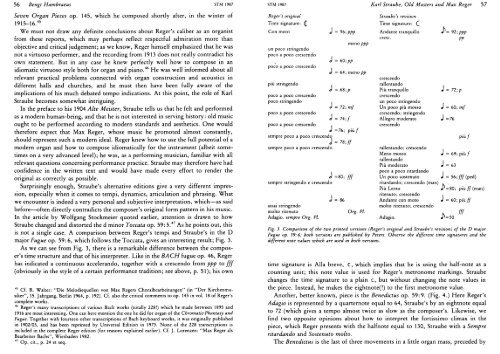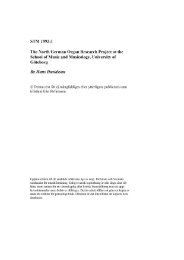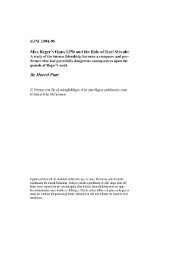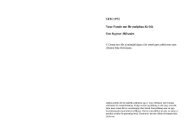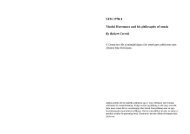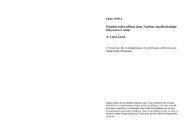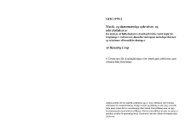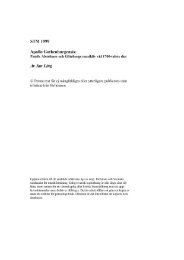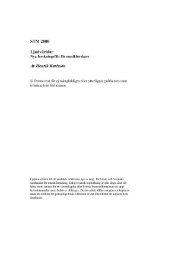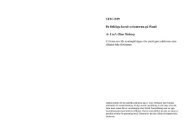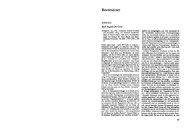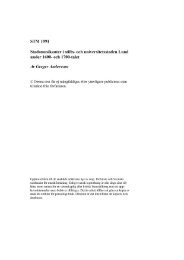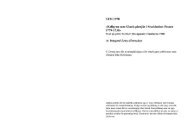Create successful ePaper yourself
Turn your PDF publications into a flip-book with our unique Google optimized e-Paper software.
Seven Organ Pieces op. 145, which he composed shortly after, in the winter of<br />
191 5-1 6. 45<br />
We must not draw any definite conclusions about Reger’s caliber as an organist<br />
from these reports, which may perhaps reflect respectful admiration more than<br />
objective and critical judgement; as we know, Reger himself emphasized that he was<br />
not a virtuoso performer, and the recording from 1913 does not really contradict his<br />
own statement. But in any case he knew perfectly well how to compose in an<br />
idiomatic virtuoso style both for organ and piano.46 He was well informed about all<br />
relevant practical problems connected with organ construction and acoustics in<br />
different halls and churches, and he must then have been fully aware of the<br />
implications of his much debated tempo indications. At this point, the role of Karl<br />
Straube becomes somewhat intriguing.<br />
In the preface to his 1904 Alte Meister, Straube tells us that he felt and performed<br />
as a modern human-being, and that he is not interested in serving history: old music<br />
ought to be performed according to modern standards and aesthetics. One would<br />
therefore expect that Max Reger, whose music he promoted almost constantly,<br />
should represent such a modern ideal. Reger knew how to use the full potential of a<br />
modern organ and how to compose idiomatically for the instrument (albeit sometimes<br />
on a very advanced level); he was, as a performing musician, familiar with all<br />
relevant questions concerning performance practice. Straube may therefore have had<br />
confidence in the written text and would have made every effort to render the<br />
original as correctly as possible.<br />
Surprisingly enough, Straube’s alternative editions give a very different impression,<br />
especially when it comes to tempi, dynamics, articulation and phrasing. What<br />
we encounter is indeed a very personal and subjective interpretation, which-as said<br />
before— often directly contradicts the composer’s original form pattern in his music.<br />
In the article by Wolfgang Stockmeier quoted earlier, attention is drawn to how<br />
Straube changed and distorted the d minor Toccata op. 59: 5.47 As he points out, this<br />
is not a single case. A comparison between Reger’s tempi and Straube’s in the D<br />
major Fugue op. 59: 6, which follows the Toccata, gives an interesting result; Fig. 3.<br />
As we can see from Fig. 3, there is a remarkable difference between the composer’s<br />
time structure and that of his interpreter. Like in the BACH fugue op. 46, Reger<br />
has indicated a continuous accelerando, together with a crescendo from ppp to fff<br />
(obviously in the style of a certain performance tradition; see above, p. 51); his own<br />
45<br />
Cf. R. Walter: “Die Melodiequellen von Max Regers Choralbearbeitungen” (in “Der Kirchenmusiker”,<br />
15. Jahrgang, Berlin 1964, p. 192). Cf. also the critical comments to op. 145 in vol. 18 of Reger’s<br />
complete works.<br />
46<br />
Reger’s many transcriptions of various Bach works (totally 228!) which he made between 1895 and<br />
1916 are most interesting. One can here mention the one he did for organ of the ChromaticPhantasy and<br />
Fugue. Together with fourteen other transcriptions of Bach keyboard works, it was originally published<br />
in 1902/03, and has been reprinted by Universal Edition in 1973. None of the 228 transcriptions is<br />
included in the complete Reger edition (for reasons explained earlier). Cf. J. Lorenzen: “Max Reger als<br />
Bearbeiter Bachs”, Wiesbaden 1982.<br />
47<br />
Op. cit., p. 24 et seq.<br />
Reger’s original<br />
Time signature:<br />
Straube’s revision<br />
Time signature:<br />
Con moto = 56; ppp Andante tranquillo 92; ppp<br />
un poco stringendo<br />
poco a poco crescendo<br />
poco a poco crescendo<br />
meno PPP<br />
= 60; pp<br />
= 64; meno pp<br />
cresc.<br />
crescendo<br />
PP<br />
più stringendo<br />
= 68; p<br />
rallen tando<br />
Più tranquillo J = 72; p<br />
poco a poco crescendo crescendo<br />
poco stringendo<br />
= 72; mf<br />
un poco stringendo<br />
Un poco più mosso J = 60; mf<br />
poco a poco crescendo<br />
= 74; f<br />
crescendo; stringendo<br />
Allegro moderato J =76<br />
poco a poco crescendo<br />
=76; più f<br />
crescendo<br />
sempre poco a poco crescendo<br />
= 78; ff<br />
sempre poco a poco crescendo<br />
rallentando; crescendo<br />
Meno mosso<br />
J = 69; più f<br />
rallentando<br />
Più moderato J = 63<br />
=80; fff<br />
sempre stringendo e crescendo<br />
poco a poco ritardando<br />
Un poco sostenuto J = 56; fff (ped)<br />
ritardando; crescendo (man)<br />
Più Lento<br />
ritenuto; crescendo<br />
=80; più ff (man)<br />
= 86<br />
Andante con moto = 60; più ff<br />
assai stringendo<br />
molto ritenuto<br />
Adagio. sempre Org. Pl.<br />
Org. Pl.<br />
molto ritenuto; crescendo<br />
Adagio.<br />
fff<br />
=50<br />
Fig. 3. Comparison of the two printed versions (Reger’s original and Straube’s revision) of the D major<br />
Fugue op. 59:6; both versions are published by Peters. Observe the different time signatures and the<br />
different note values which are used in both versions.<br />
time signature is Alla breve, which implies that he is using the half-note as a<br />
counting unit; this note value is used for Reger’s metronome markings. Straube<br />
changes the time signature to a plain , but without changing the note values in<br />
the piece. Instead, he makes the eightnote(!) to the first metronome value.<br />
Another, better known, piece is the Benedictus op. 59:9. (Fig. 4.) Here Reger’s<br />
Adagio is represented by a quarternote equal to 64, Straube’s by an eightnote equal<br />
to 72 (which gives a tempo almost twice as slow as the composer’s. Likewise, we<br />
find two opposite opinions about how to interpret the fortissimo climax in the<br />
piece, which Reger presents with the halfnote equal to 130, Straube with a Sempre<br />
ritardando and Sostenuto molto.<br />
The Benedictus is the last of three movements in a little organ mass, preceded by<br />
più f


